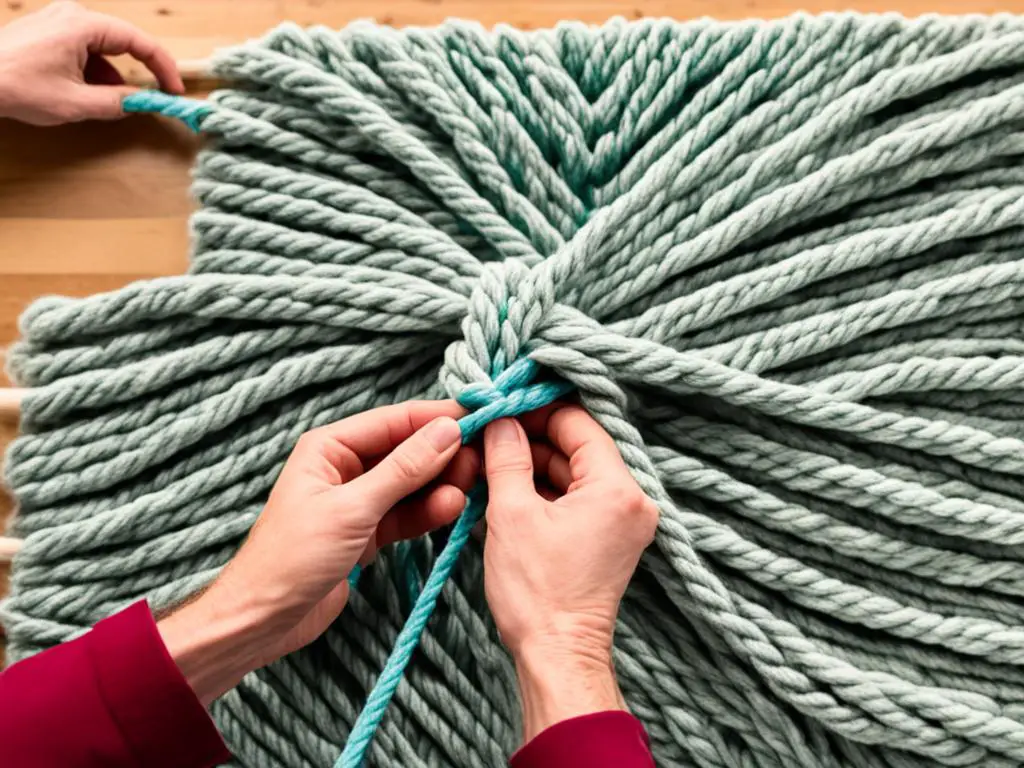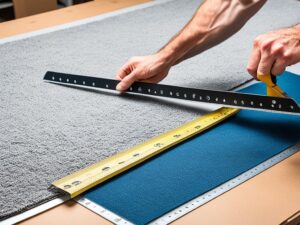Hand-knotting rugs is an ancient art form that has been practiced for thousands of years. It involves a meticulous process of tying individual knots onto warp threads, resulting in beautiful and durable handmade rugs. In this rug knotting tutorial, we will explore the intricate techniques and materials used in creating these works of art.
Key Takeaways:
- Hand-knotting rugs is a labor-intensive process that requires skill and precision.
- The quality of a hand-knotted rug is determined by factors such as knot count, wool quality, design, and place of origin.
- There are different rug knotting techniques, like the Persian knot and the Turkish knot, each with its own characteristics.
- Hand-knotted rugs can be made with silk, wool, or a combination of both, each providing unique properties.
- Investing in a hand-knotted rug is a meaningful purchase that showcases craftsmanship and can be passed down through generations.
Understanding Different Rug Knotting Techniques
Hand-knotted rugs are created using various rug knotting techniques, each with its own distinct characteristics and applications. Two commonly used techniques are the Persian knot and the Turkish knot.
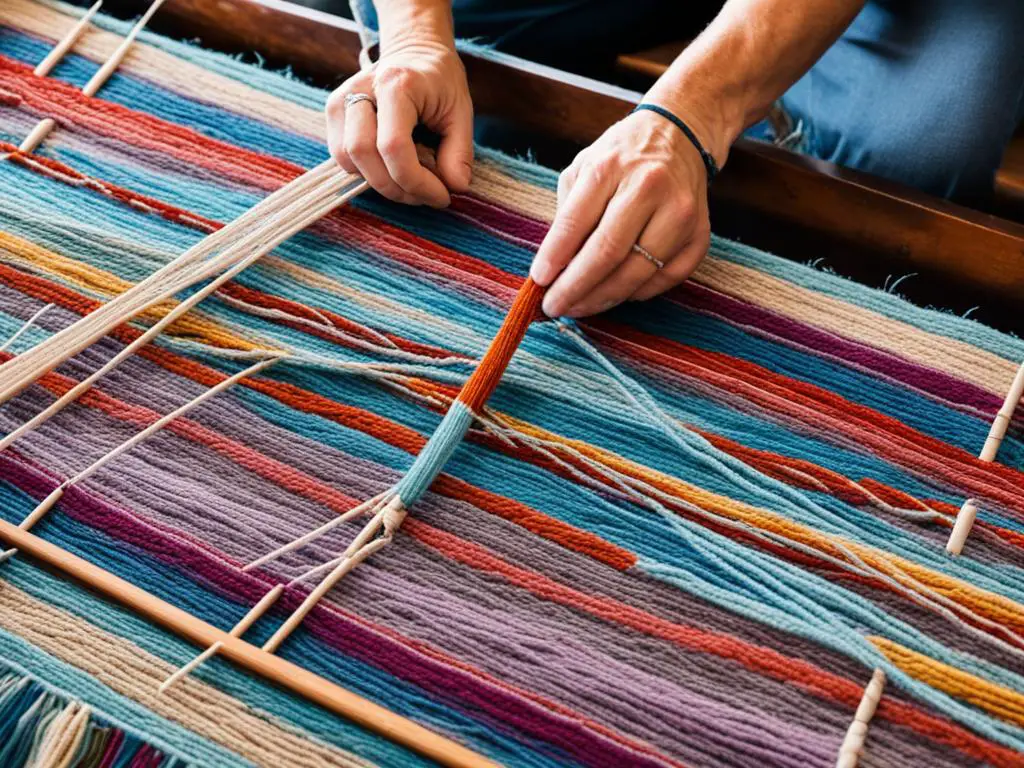
The Persian knot, also known as the Senneh knot, is unsymmetrical and open on either side. This type of knot is well-suited for rugs with high knot density and intricate patterns. The asymmetry allows for more intricate design variations.
The Turkish knot, also known as the Ghiordes knot, is symmetrical and creates a consistent pile height. It is often used in thicker carpets and rugs. The uniformity of the Turkish knot enables a more even distribution of the pile, resulting in a dense and luxurious texture.
The rug knotting process involves tying each knot individually onto the warp threads, forming the foundation of the rug. The yarn is meticulously woven and knotted, creating the desired pattern and texture. This labor-intensive technique contributes to the exceptional quality and durability of hand-knotted rugs.
Exploring Rug Materials: Silk, Wool, and Bamboo Silk
Hand-knotted rugs are renowned for their exquisite craftsmanship and timeless beauty. To create these masterpieces, skilled artisans carefully select the finest materials. Let’s delve into the world of hand-knotted rug materials and discover the unique qualities they bring to the tapestry.
The Elegance of Silk
Silk is a luxurious and highly sought-after material in the creation of hand-knotted rugs. It boasts a lustrous sheen that adds an air of opulence to any space. Not only is silk visually stunning, but it also offers exceptional durability. However, silk rugs tend to be more delicate and require extra care to maintain their pristine condition.
The Durability of Wool
Wool is a popular choice due to its durability and hypoallergenic properties. It is known for its ability to withstand heavy foot traffic while maintaining its original shape and texture. Wool rugs offer warmth and coziness, making them perfect for creating a welcoming atmosphere in any room. Additionally, wool is a sustainable and renewable material, making it an eco-friendly choice for rug enthusiasts.
The Eco-Friendliness of Bamboo Silk
Bamboo silk is a sustainable alternative to traditional silk. Derived from the cellulose fibers of bamboo plants, it offers a similar lustrous finish without compromising on quality. Bamboo silk is an eco-friendly option as it requires less water and pesticides during cultivation. By incorporating bamboo silk into hand-knotted rugs, artisans can create stunning pieces without impacting the environment.
Rug Materials Comparison:
| Material | Features | Benefits |
|---|---|---|
| Silk | Lustrous sheen | Added elegance and visual appeal |
| Wool | Durable and hypoallergenic | Long-lasting and suitable for allergy sufferers |
| Bamboo Silk | Eco-friendly alternative | Reduced environmental impact |
When embarking on a DIY hand-knotted rug project or exploring the world of rug knotting as a beginner, it is essential to choose high-quality materials that align with your desired aesthetic and environmental values. Whether you opt for the luxurious allure of silk, the durability of wool, or the eco-friendliness of bamboo silk, selecting the right materials will contribute to the exceptional quality of your hand-knotted rug.
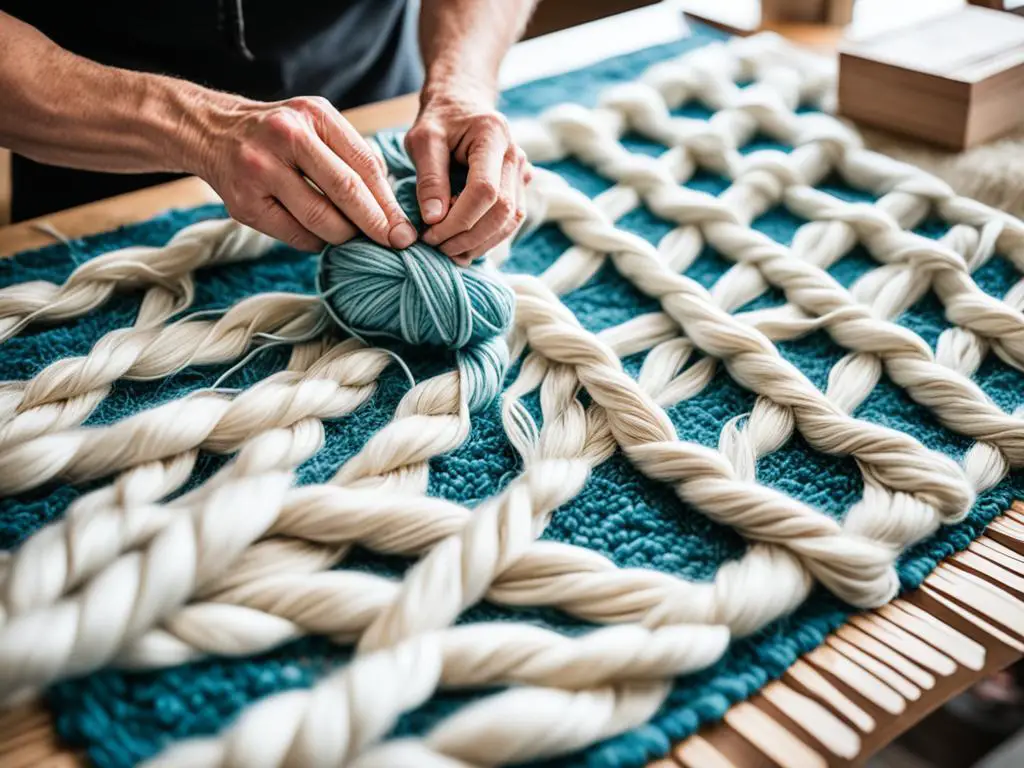
The Cost of Hand-Knotted Rugs
When it comes to hand-knotted rugs, quality craftsmanship comes at a price. The labor-intensive nature of hand-knotting drives up the cost compared to machine-made rugs. Skilled weavers devote months, and sometimes even years, to create a single hand-knotted rug, resulting in a higher price tag. However, the investment is well worth it for those seeking a truly exceptional piece.
Hand-knotted rugs are more than just floor coverings; they are works of art that can be passed down through generations. Each rug carries a story, representing the painstaking efforts of the weaver and showcasing their skill and creativity. With intricate detailing and impeccable craftsmanship, hand-knotted rugs add a touch of elegance and sophistication to any space.
On the other hand, machine-made or hand-tufted rugs offer a more affordable alternative but lack the uniqueness and attention to detail found in hand-knotted rugs. While these rugs may serve their purpose, they often fail to capture the same level of artistry and longevity.
For those who appreciate the true beauty and value of a hand-knotted rug, the cost is not just measured in dollars but in the joy and satisfaction it brings. Investing in a hand-knotted rug is an investment in artistry, tradition, and timeless beauty that will continue to enhance your space for years to come.
| Hand-Knotted Rugs | Machine-Made Rugs | |
|---|---|---|
| Cost | Higher | Lower |
| Craftsmanship | Impeccable | Limited |
| Unique | Yes | No |
| Longevity | Durable | Variable |
Determining Rug Quality
The quality of a hand-knotted rug can be determined by several factors. One important aspect to consider is the number of knots per square inch, also known as knots per square inch (kpsi). A higher kpsi indicates a finer and higher-quality rug.
In general, a hand-knotted rug with a kpsi of 100-200 is considered to be of good quality, while a kpsi over 200 is exceptional.
Examining the back of the rug can also provide insights into its quality. A hand-knotted rug will have a consistent and well-defined pattern on both the front and back, reflecting the attention to detail and craftsmanship that goes into its creation.
Hand-knotted rugs are renowned for their durability and ability to withstand high traffic areas. The intricate knotting technique ensures that the rug remains intact even with frequent use, making it a long-lasting investment for your home.
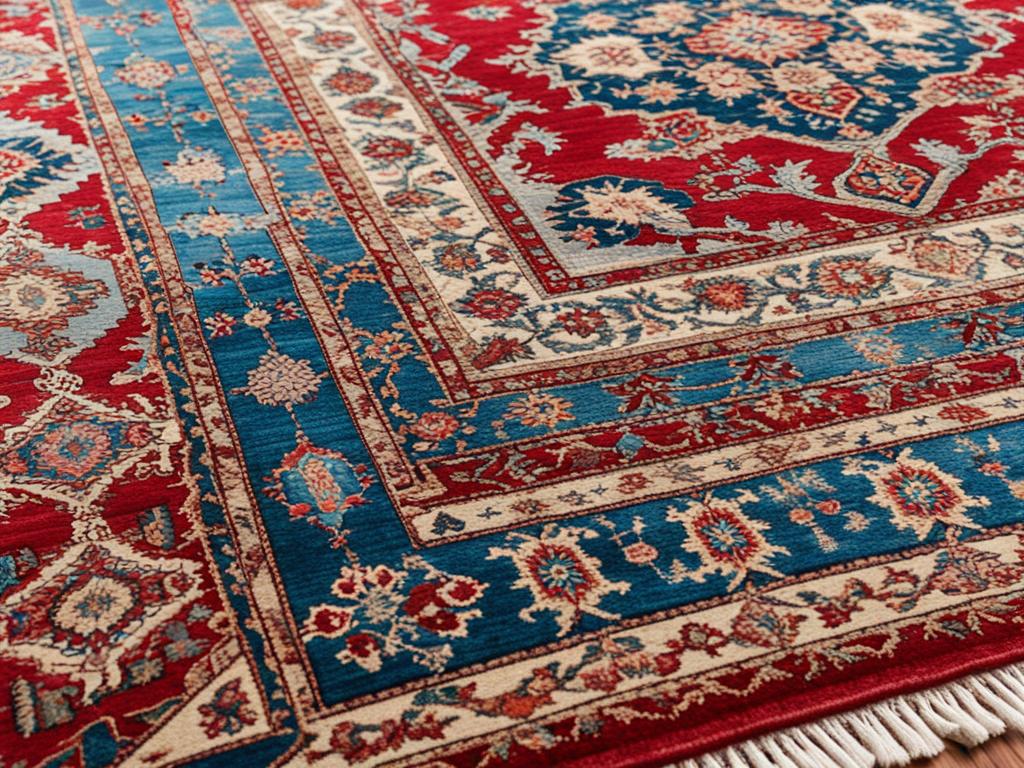
When purchasing a hand-knotted rug, it is crucial to examine the quality to ensure you are getting a genuine and well-crafted piece. A rug of higher quality will not only enhance the aesthetics of your space but also provide comfort and durability for years to come.
Designing a Hand-Knotted Rug
When it comes to hand-knotted rugs, the design possibilities are limitless. Whether you prefer contemporary or traditional styles, these rugs can be customized to suit your taste and enhance the beauty of your space. When designing a hand-knotted rug, there are certain factors to consider that will help you create a visually stunning and unique piece.
Materials and Colors
The choice of materials and colors is crucial in designing a hand-knotted rug. The materials used, such as silk or wool, can greatly influence the overall look and feel of the rug. Silk adds a luxurious and lustrous finish, while wool provides durability and a cozy texture. Consider the specific parts of your design that you want to accentuate and choose colors accordingly. By carefully selecting the materials and colors, you can bring your vision to life and create a rug that truly stands out.
Intricate Patterns
Hand-knotted rugs are known for their intricate patterns and attention to detail. These rugs can feature hundreds of colors woven together to create stunning and complex designs. Whether you opt for geometric shapes, floral motifs, or abstract patterns, the skilled artisans can bring your design to life with precision and expertise. The intricate patterns of hand-knotted rugs make them true works of art that can elevate any space.
Displaying on Walls
Vintage hand-knotted rugs, with their detailed and artistic designs, are often considered more than just floor coverings. They can also be displayed on walls as decorative pieces. The intricate colors and patterns of these rugs create a visually stunning focal point, adding character and warmth to your wall space. By showcasing a hand-knotted rug on your wall, you can transform your room into a gallery-like setting.
Designing a hand-knotted rug gives you the opportunity to create a unique and visually captivating piece that reflects your personal style. With endless design possibilities and the skill of experienced artisans, you can bring your vision to life and own a truly one-of-a-kind rug.
The Knot Types and Techniques
Hand-knotted rugs utilize different knot types and techniques to create unique and intricate designs. Let’s explore the main knot types used in hand-knotting:
Turkish Knot
The symmetric Turkish knot, also known as the Ghiordes knot, is commonly used in traditional Turkish rug making. This knot is tied by looping the yarn around two warp threads and then pulling it through the middle, creating a symmetrical knot. The Turkish knot results in a consistent pile height and is often used in thicker carpets.
Persian Knot
The asymmetric Persian knot, also called the Senneh knot, is widely used in Persian and Oriental rugs. This knot is created by looping the yarn around a single warp thread and then pulling it through. The Persian knot is open on one side, allowing for intricate and detailed designs with higher knot density.
Jufti Knot
The jufti knot, also known as the false knot, is a technique used to save on materials and reduce production time. Instead of tying each knot around individual warp threads, the weaver ties the knot around pairs of warp threads. While this knotting technique can help create unique patterns, it may result in less durable rugs.
Tibetan Knot
Tibetan knots are commonly used in rugs made in Tibet and other Himalayan regions. This technique involves using a rod to create knots, allowing for faster and more efficient production. The Tibetan knot creates a loop of yarn across two warp threads, resulting in a unique and distinct design.
Each knotting technique contributes to the overall pattern and durability of the hand-knotted rug, showcasing the exceptional craftsmanship and attention to detail involved in the rug-making process.
| Knot Type | Description |
|---|---|
| Turkish Knot | Symmetric knot used in traditional Turkish rugs. |
| Persian Knot | Asymmetric knot used in Persian and Oriental rugs. |
| Jufti Knot | Technique that saves on materials and production time. |
| Tibetan Knot | Knotting technique used in rugs made in Tibet and the Himalayan region. |
Explore the next section to learn more about the cost of hand-knotted rugs and factors that determine their price.
Conclusion
Hand-knotting rugs is a labor of love that yields exceptional results. The meticulous process of tying individual knots onto the warp threads produces rugs of unparalleled quality and durability. This ancient art form, passed down through generations, continues to captivate with its timeless craftsmanship and beauty.
Whether you are a novice or an experienced rug maker, hand knotting offers a truly rewarding creative experience. The intricate patterns, vibrant colors, and luxurious materials allow you to create unique pieces that reflect your personal style and taste. Each hand-knotted rug tells a story, making it a meaningful addition to any space.
Investing in a hand-knotted rug is more than just acquiring a floor covering; it is acquiring a work of art. These rugs are made to withstand the test of time, becoming cherished heirlooms that can be passed down for generations. With their exceptional quality and timeless appeal, hand-knotted rugs are a testament to the skill and dedication of the artisans who create them.
